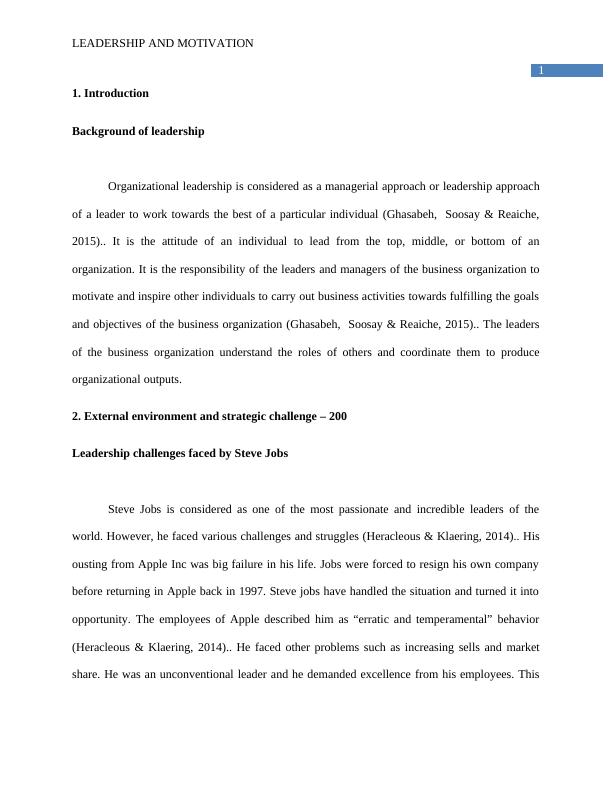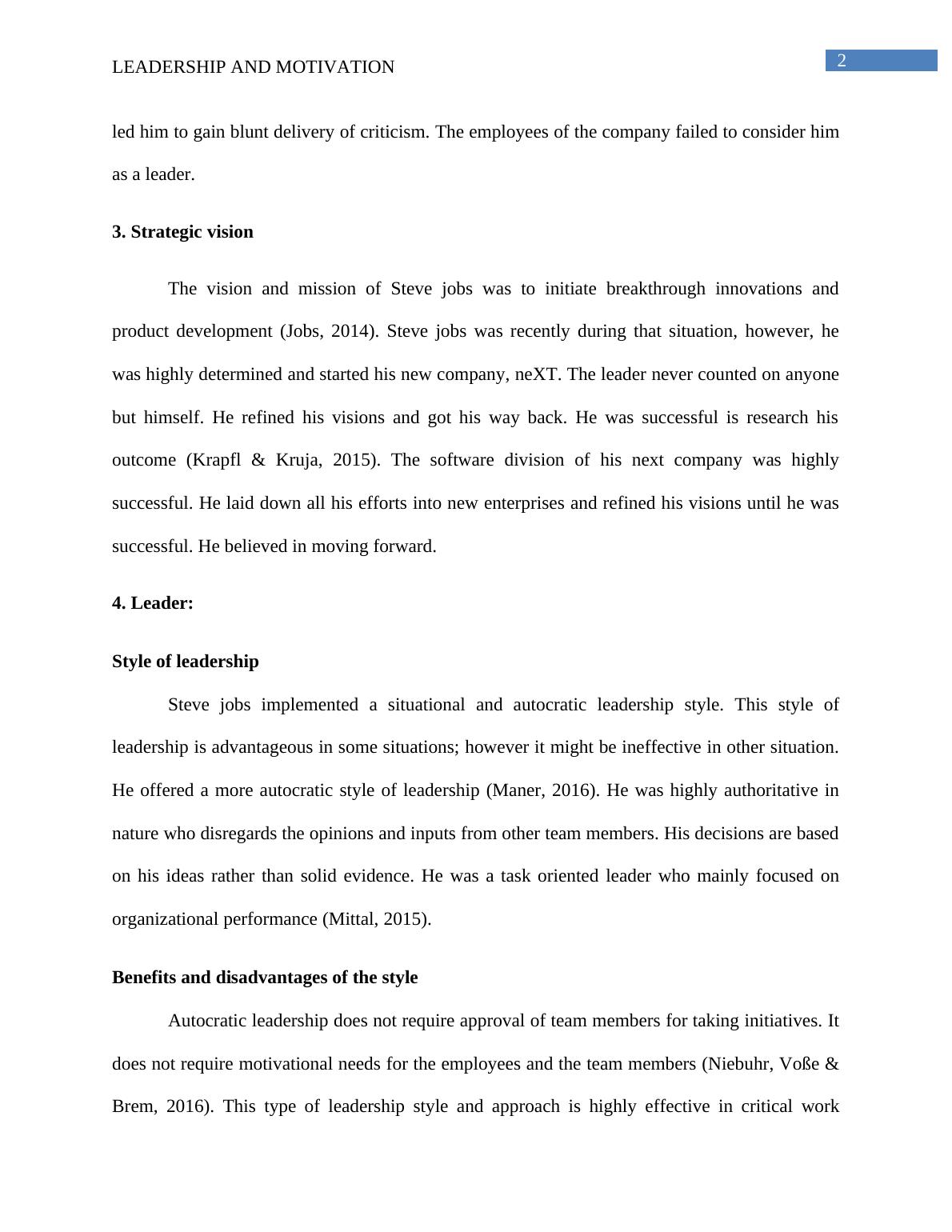Organizational Leadership | Report
Added on 2022-08-19
10 Pages2193 Words18 Views
Running head: LEADERSHIP AND MOTIVATION
LEADERSHIP AND MOTIVATION
Student Name
University Name
Author note
LEADERSHIP AND MOTIVATION
Student Name
University Name
Author note

1
LEADERSHIP AND MOTIVATION
1. Introduction
Background of leadership
Organizational leadership is considered as a managerial approach or leadership approach
of a leader to work towards the best of a particular individual (Ghasabeh, Soosay & Reaiche,
2015).. It is the attitude of an individual to lead from the top, middle, or bottom of an
organization. It is the responsibility of the leaders and managers of the business organization to
motivate and inspire other individuals to carry out business activities towards fulfilling the goals
and objectives of the business organization (Ghasabeh, Soosay & Reaiche, 2015).. The leaders
of the business organization understand the roles of others and coordinate them to produce
organizational outputs.
2. External environment and strategic challenge – 200
Leadership challenges faced by Steve Jobs
Steve Jobs is considered as one of the most passionate and incredible leaders of the
world. However, he faced various challenges and struggles (Heracleous & Klaering, 2014).. His
ousting from Apple Inc was big failure in his life. Jobs were forced to resign his own company
before returning in Apple back in 1997. Steve jobs have handled the situation and turned it into
opportunity. The employees of Apple described him as “erratic and temperamental” behavior
(Heracleous & Klaering, 2014).. He faced other problems such as increasing sells and market
share. He was an unconventional leader and he demanded excellence from his employees. This
LEADERSHIP AND MOTIVATION
1. Introduction
Background of leadership
Organizational leadership is considered as a managerial approach or leadership approach
of a leader to work towards the best of a particular individual (Ghasabeh, Soosay & Reaiche,
2015).. It is the attitude of an individual to lead from the top, middle, or bottom of an
organization. It is the responsibility of the leaders and managers of the business organization to
motivate and inspire other individuals to carry out business activities towards fulfilling the goals
and objectives of the business organization (Ghasabeh, Soosay & Reaiche, 2015).. The leaders
of the business organization understand the roles of others and coordinate them to produce
organizational outputs.
2. External environment and strategic challenge – 200
Leadership challenges faced by Steve Jobs
Steve Jobs is considered as one of the most passionate and incredible leaders of the
world. However, he faced various challenges and struggles (Heracleous & Klaering, 2014).. His
ousting from Apple Inc was big failure in his life. Jobs were forced to resign his own company
before returning in Apple back in 1997. Steve jobs have handled the situation and turned it into
opportunity. The employees of Apple described him as “erratic and temperamental” behavior
(Heracleous & Klaering, 2014).. He faced other problems such as increasing sells and market
share. He was an unconventional leader and he demanded excellence from his employees. This

2
LEADERSHIP AND MOTIVATION
led him to gain blunt delivery of criticism. The employees of the company failed to consider him
as a leader.
3. Strategic vision
The vision and mission of Steve jobs was to initiate breakthrough innovations and
product development (Jobs, 2014). Steve jobs was recently during that situation, however, he
was highly determined and started his new company, neXT. The leader never counted on anyone
but himself. He refined his visions and got his way back. He was successful is research his
outcome (Krapfl & Kruja, 2015). The software division of his next company was highly
successful. He laid down all his efforts into new enterprises and refined his visions until he was
successful. He believed in moving forward.
4. Leader:
Style of leadership
Steve jobs implemented a situational and autocratic leadership style. This style of
leadership is advantageous in some situations; however it might be ineffective in other situation.
He offered a more autocratic style of leadership (Maner, 2016). He was highly authoritative in
nature who disregards the opinions and inputs from other team members. His decisions are based
on his ideas rather than solid evidence. He was a task oriented leader who mainly focused on
organizational performance (Mittal, 2015).
Benefits and disadvantages of the style
Autocratic leadership does not require approval of team members for taking initiatives. It
does not require motivational needs for the employees and the team members (Niebuhr, Voße &
Brem, 2016). This type of leadership style and approach is highly effective in critical work
LEADERSHIP AND MOTIVATION
led him to gain blunt delivery of criticism. The employees of the company failed to consider him
as a leader.
3. Strategic vision
The vision and mission of Steve jobs was to initiate breakthrough innovations and
product development (Jobs, 2014). Steve jobs was recently during that situation, however, he
was highly determined and started his new company, neXT. The leader never counted on anyone
but himself. He refined his visions and got his way back. He was successful is research his
outcome (Krapfl & Kruja, 2015). The software division of his next company was highly
successful. He laid down all his efforts into new enterprises and refined his visions until he was
successful. He believed in moving forward.
4. Leader:
Style of leadership
Steve jobs implemented a situational and autocratic leadership style. This style of
leadership is advantageous in some situations; however it might be ineffective in other situation.
He offered a more autocratic style of leadership (Maner, 2016). He was highly authoritative in
nature who disregards the opinions and inputs from other team members. His decisions are based
on his ideas rather than solid evidence. He was a task oriented leader who mainly focused on
organizational performance (Mittal, 2015).
Benefits and disadvantages of the style
Autocratic leadership does not require approval of team members for taking initiatives. It
does not require motivational needs for the employees and the team members (Niebuhr, Voße &
Brem, 2016). This type of leadership style and approach is highly effective in critical work

End of preview
Want to access all the pages? Upload your documents or become a member.
Related Documents
Apple under the leadership of Steve Jobslg...
|23
|4915
|175
Leading in an organizationlg...
|5
|803
|70
An Empowering Leader: Steve Jobslg...
|4
|769
|425
Leading in an Organisationlg...
|6
|1201
|1
Charismatic Leadership of Steve Jobs Assignmentlg...
|9
|2035
|172
Management and Leadershiplg...
|5
|1328
|87
